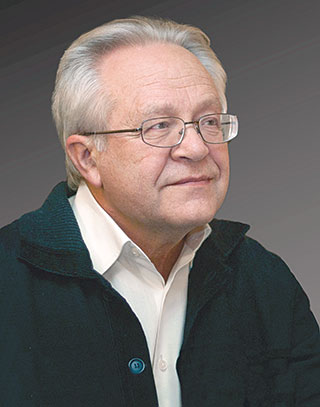Vsevolod Feliksovich Gantmakher
DOI: 10.1063/PT.3.2890
Vsevolod Feliksovich “Seva” Gantmakher was an innovator in the field of quantum transport. His discoveries provided a powerful tool and a direct means to study an unprecedented range of phenomena in Fermi liquids. The Gantmakher effect, which has become a household name and the basis for many developments, eventually opened the door to quantum mesoscopic physics. A pivotal figure in Russian physics, Seva was a mentor for generations of students and one of the founders of the peer-refereed grant system in Russia. As editor-in-chief of JETP Letters for more than 20 years, he navigated the journal through the difficult post-Soviet period.

Vsevolod Feliksovich Gantmakher

Seva was born on 8 October 1935 in Moscow to the family of a prominent mathematician. In 1954 he was admitted to the Moscow Institute of Physics and Technology, or Phystech. As a sophomore he started experimental work at the Institute for Physical Problems, the home of Peter Kapitza and Lev Landau. Landau’s fermiology, the hot area of the day, called for new experimental techniques for mapping out exotic shapes of Fermi surfaces and exploring the related transport phenomena.
Seva’s new idea was to switch from microwave frequencies, used previously for spectroscopy of cyclotron orbits, to radio frequencies. The RFs couple efficiently to grazing electrons in a thin “skin” layer at metal surfaces, which allows researchers to select specific cyclotron orbits and probe them through ballistic penetration of the RF field into a metal. That groundbreaking work propelled Seva to the world stage. Perhaps the best way to gauge its impact on contemporaries, and to tap into the flavor of the epoch, is to quote Robert Chambers, who at a 1968 conference presented Seva’s research in his absence:
It is not often that an experimentalist derives a new technique as simple, elegant and powerful as the Gantmakher effect, and it is not often that the originator of the new technique has both the experimental and the theoretical expertise to explore its possibilities as thoroughly as Gantmakher has done. He was invited to describe his work at the Gordon Conference on Metals in 1967 … and again at the present meeting, but unhappily he has been prevented from accepting any of these invitations, and the present writer has reluctantly spoken in his place.
It is not often that an experimentalist derives a new technique as simple, elegant and powerful as the Gantmakher effect, and it is not often that the originator of the new technique has both the experimental and the theoretical expertise to explore its possibilities as thoroughly as Gantmakher has done. He was invited to describe his work at the Gordon Conference on Metals in 1967 … and again at the present meeting, but unhappily he has been prevented from accepting any of these invitations, and the present writer has reluctantly spoken in his place.
After completing his PhD in 1964 under Yuri Sharvin on the high- frequency properties of metals, Seva moved to the newly established Institute of Solid State Physics in Chernogolovka, which became the stage for his long and productive career. Always on the lookout for new and exciting things, he created a laboratory that explored frontiers of electron transport, covering topics as diverse as transverse focusing, hot carriers, superconductivity, and localization; his personal favorite in his later years was localization of Cooper pairs. Such breadth, as well as the creative atmosphere and Seva’s personality—demanding but always fair and benevolent—helped to attract the best young researchers.
Seva’s career spanned some exciting but difficult periods of his country’s history. As a wise man said, we don’t decide on what times we live in, “all we have to decide is what to do with the time that is given to us.” Which is what Seva did flawlessly. He is remembered fondly for the multiple ways he shaped the academic community, in particular how he promoted and supported the rules of scientific ethics.
No less important was his firm standing on civil issues. After becoming a professor at Phystech, he acted as an academic representative in undergraduate admissions. At the time, the Soviet system at all levels discriminated against certain “undesirable” ethnicities, especially those of Jewish and German descent. That made undergraduate admissions at prestigious universities a politically charged issue. Seva did his best to improve the chances of the applicants who were subjected to discrimination. His interventions were defining moments in the lives of many future physicists, including one of us (Geim). When, 40 years ago, the admission committee went into a whisper about “another one,” Seva broke in with a firm “I’ll take him.”
His books Electrons and Disorder in Solids (Oxford University Press, 2005) and Carrier Scattering in Metals and Semiconductors (written with Yehoshua Levinson, Elsevier, 1987) have remained eminently popular. Seva’s creation and pride, the JETP Letters website (http://www.jetpletters.ac.ru/ps/index-v-ten_1.shtml
Seva was a charming and cheerful person whose sports preferences and lifestyle changed gradually with age, from mountaineering and motorcycling to cross-country skiing and driving a car. His exceptional sense of humor, generosity, openness, and wisdom invariably attracted people to him. The New Year’s Eve parties in his apartment were the joy of Chernogolovka. He lived a highly productive and vibrant life until his death on 5 March 2015 following a battle with cancer. He will be sorely missed by his family, friends, and colleagues.
More about the Authors
Andre Geim. University of Manchester, Manchester, UK.
Leonid Levitov. Massachusetts Institute of Technology, Cambridge.
Emmanuel Rashba. Harvard University, Cambridge, Massachusetts.
